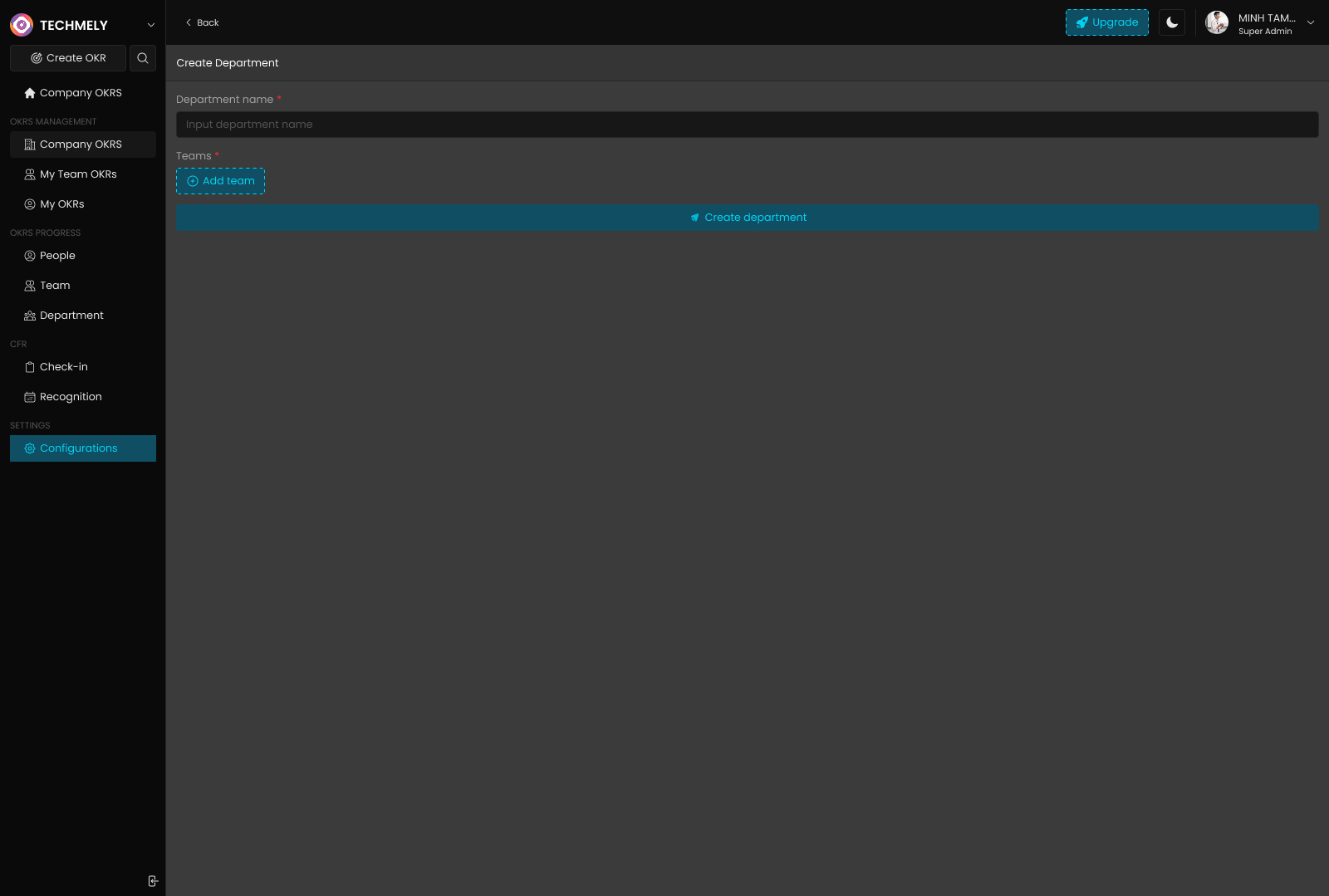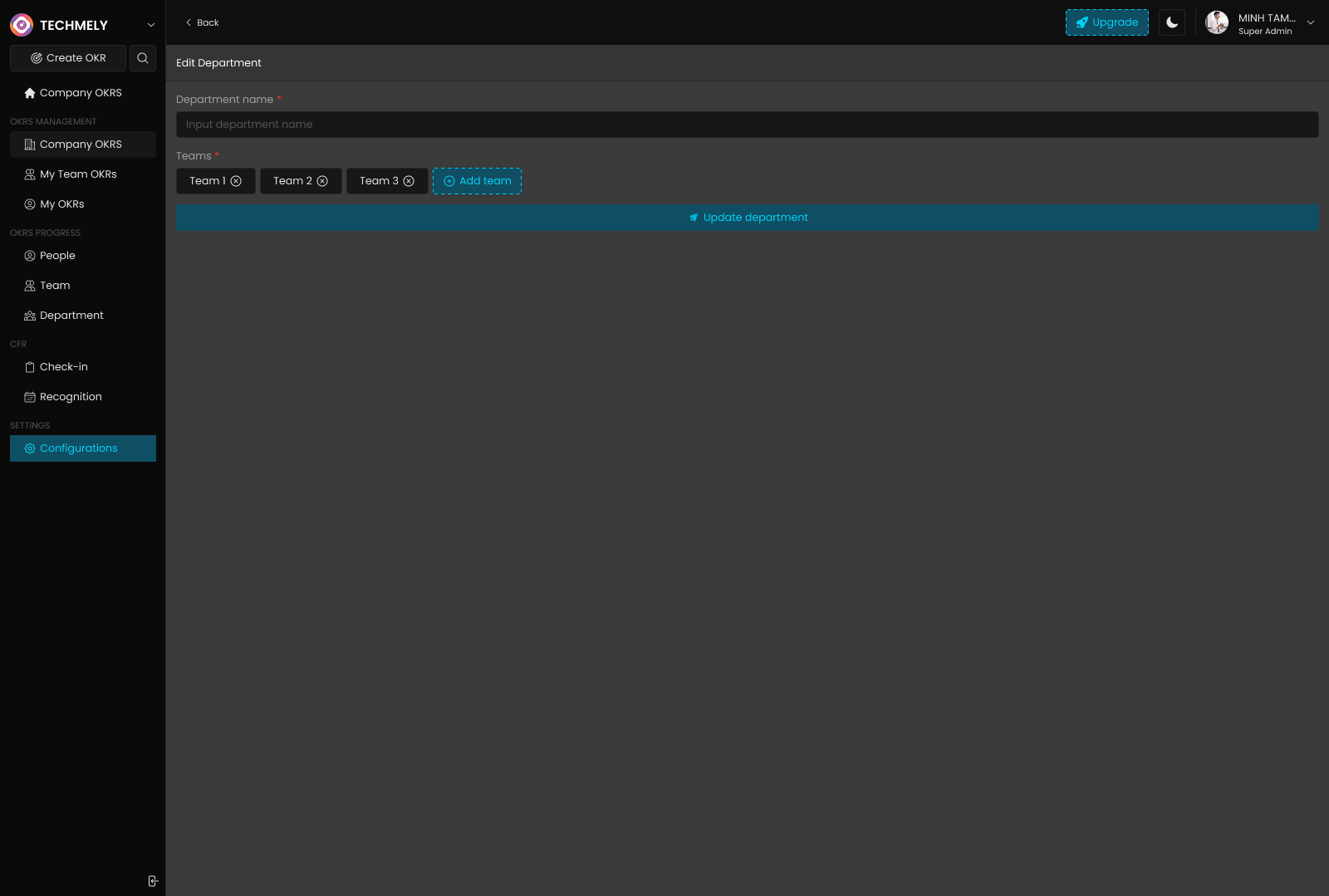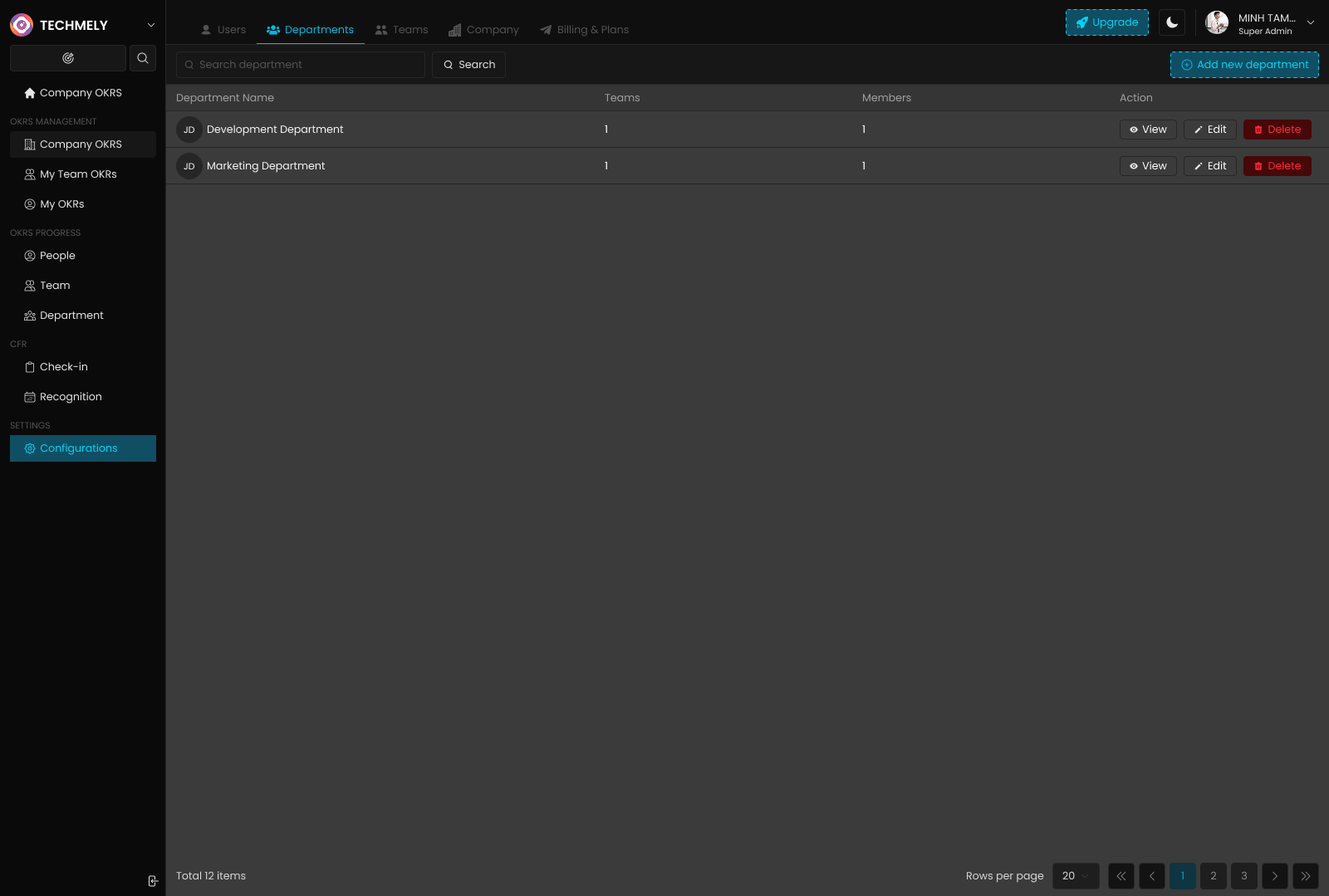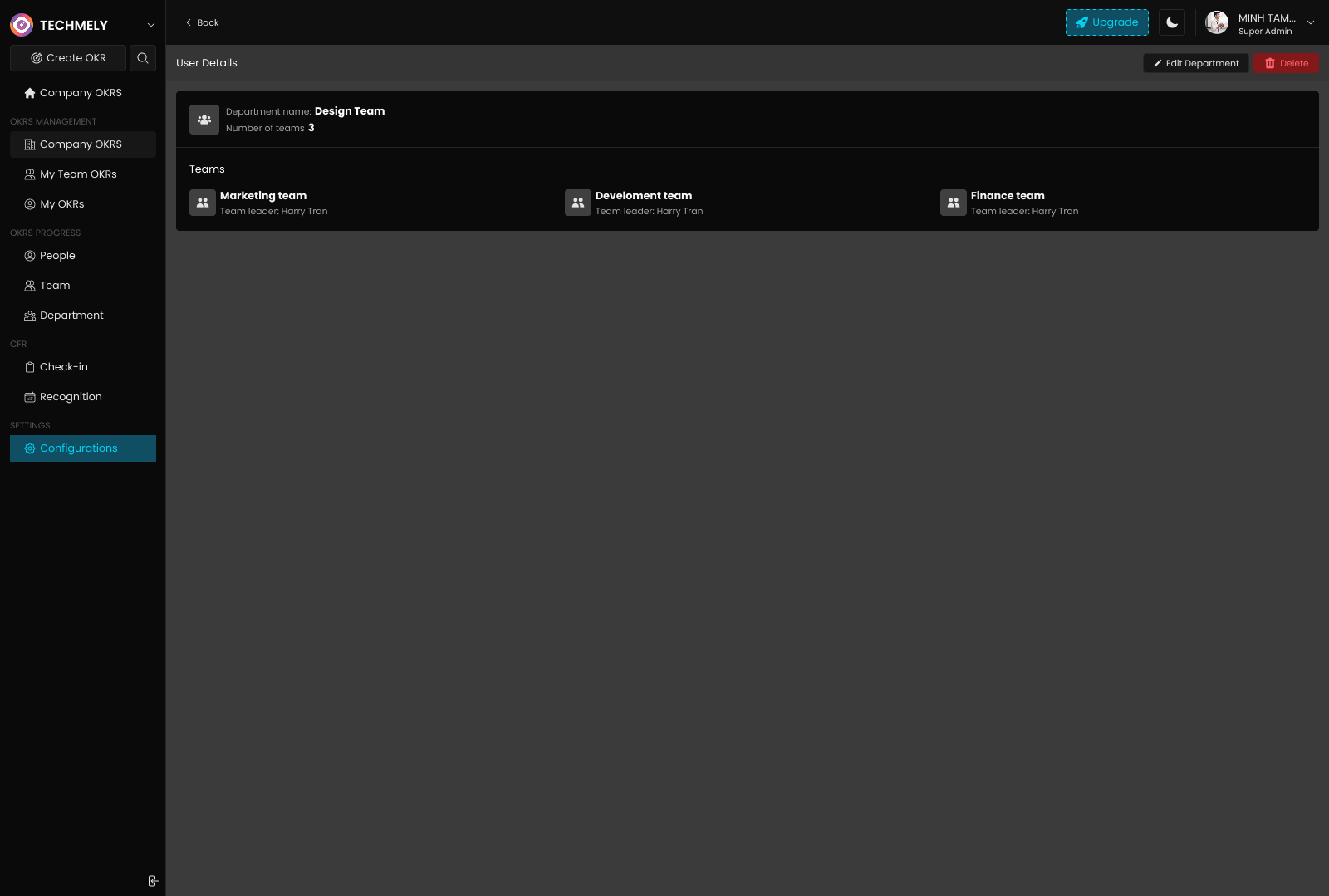Department Management
Complete guide to creating, managing, and organizing departments and teams within your AntOKR organization
Department Management
Overview
Department Management provides a structured approach to organizing your organization's teams and resources within AntOKR. This powerful administrative tool allows you to create logical groupings of teams, manage departmental hierarchies, and establish clear organizational structures that support effective OKR implementation and performance tracking.
Understanding Departmental Structure
Departments serve as the organizational framework that houses multiple teams working toward related objectives. This hierarchical structure enables better resource allocation, clearer reporting lines, and more effective strategic alignment across your organization.
Key Benefits
- Organizational Clarity: Clear structure for teams and reporting relationships
- Resource Management: Efficient allocation and tracking of departmental resources
- Strategic Alignment: Better connection between departmental goals and company objectives
- Performance Tracking: Consolidated view of departmental progress and achievements
- Scalability: Flexible structure that grows with your organization
Creating a New Department
The department creation process is straightforward and allows you to establish the foundational structure for organizing your teams.

Department Creation Process
Step 1: Access Department Creation
- Navigate to the Configuration section in the sidebar
- Select Department from the navigation menu
- Click "Add new department" button to begin setup
Step 2: Configure Department Details
Department Name:
- Field: "Input department name"
- Purpose: Unique identifier for the department
- Best Practices:
- Use clear, descriptive names (e.g., "Marketing Department", "Engineering Department")
- Avoid abbreviations that might be confusing
- Consider future scalability when naming
- Maintain consistency with organizational terminology
Teams Assignment:
- Default State: Empty teams section with "Add team" option
- Team Management: Ability to assign existing teams or create new ones
- Flexible Structure: Teams can be added during creation or later
- Team Relationships: Establish clear team hierarchies within departments
Step 3: Complete Department Creation
- Enter the department name in the required field
- Add teams if available (optional during initial creation)
- Click "Create department" to finalize setup
- Verify department appears in the department list
Department Creation Best Practices
Naming Conventions:
- Descriptive Names: Use names that clearly indicate department function
- Consistency: Maintain consistent naming patterns across departments
- Future-Proofing: Choose names that won't become outdated
- Clarity: Avoid ambiguous or overly technical terminology
Organizational Structure:
- Functional Alignment: Group teams by business function or expertise
- Size Considerations: Balance department size for effective management
- Cross-Functional Needs: Consider teams that span multiple departments
- Reporting Lines: Ensure clear hierarchical relationships
Editing Department Configuration
Department configurations can be modified to accommodate organizational changes, team reassignments, and structural evolution.

Department Modification Process
Accessing Edit Mode:
- Navigate to the department list view
- Locate the target department
- Click "Edit" from the action menu
- Access the department editing interface
Editable Components:
Department Name:
- Modification: Update department name as needed
- Impact Considerations: Name changes affect all associated reporting and references
- Communication: Inform team members of name changes
- Historical Data: Previous references may need updating
Team Management:
- Current Teams: View existing team assignments (Team 1, Team 2, Team 3)
- Remove Teams: Use "×" button to remove teams from department
- Add Teams: Use "Add team" button to assign additional teams
- Team Flexibility: Teams can be reassigned between departments as needed
Step-by-Step Editing:
- Review Current Configuration: Assess existing department setup
- Make Necessary Changes: Update name and team assignments
- Validate Changes: Ensure modifications align with organizational needs
- Save Updates: Click "Update department" to apply changes
- Communicate Changes: Inform affected team members and stakeholders
Change Management Considerations
Team Reassignment Impact:
- OKR Continuity: Ensure ongoing objectives aren't disrupted
- Reporting Structure: Update reporting relationships as needed
- Access Permissions: Verify team access rights remain appropriate
- Communication Plans: Keep team members informed of changes
Department Restructuring:
- Strategic Alignment: Ensure changes support organizational goals
- Resource Allocation: Adjust resource distribution as needed
- Performance Metrics: Update tracking and measurement approaches
- Timeline Planning: Plan changes to minimize operational disruption
Department List Management
The department overview provides comprehensive visibility into your organizational structure and departmental performance.

Department Overview Interface
Navigation and Controls:
- Departments Tab: Active view showing departmental overview
- Search Functionality: "Search department" field for quick location
- Search Button: Execute search queries across departments
- Add New Department: Quick access to department creation
Department Information Display:
Data Columns:
- Department Name: Primary identifier with department icon
- Teams: Number of teams within each department
- Members: Total member count across all departmental teams
- Action: Available management operations (View, Edit, Delete)
Sample Data Analysis: Based on the interface, current departments show:
- Development Department: 1 team, 1 member
- Marketing Department: 1 team, 1 member
Management Actions:
- 👁️ View: Access detailed department information and analytics
- ✏️ Edit: Modify department configuration and team assignments
- 🗑️ Delete: Remove department (with appropriate safeguards)
Department Analytics and Insights
Performance Indicators:
- Team Distribution: Balance of teams across departments
- Member Allocation: Employee distribution and resource utilization
- Growth Patterns: Departmental expansion and contraction trends
- Efficiency Metrics: Team-to-member ratios and productivity indicators
Organizational Health Monitoring:
- Balanced Structure: Appropriate distribution of teams and members
- Resource Optimization: Efficient allocation of human resources
- Scalability Assessment: Capacity for future growth and expansion
- Structural Gaps: Identification of organizational weaknesses
Department Details and Team Management
Detailed department views provide comprehensive information about departmental structure, team composition, and performance metrics.

Department Information Panel
Department Overview:
- Department Name: Design Team (example department)
- Team Count: 3 teams within the department
- Visual Identity: Department icon for easy recognition
- Management Actions: Edit Department and Delete options
Administrative Controls:
- ✏️ Edit Department: Modify departmental configuration
- 🗑️ Delete: Remove department with appropriate safeguards
Team Structure Within Departments
Team Organization: The department details show three teams within the Design Team department:
- Marketing team: Team leader - Harry Tran
- Development team: Team leader - Harry Tran
- Finance team: Team leader - Harry Tran
Leadership Analysis:
- Centralized Leadership: Single leader across multiple teams
- Cross-Functional Oversight: Leadership spanning different functional areas
- Resource Efficiency: Optimized use of leadership resources
- Coordination Benefits: Unified approach across related teams
Team Management Insights:
- Team Distribution: Balanced allocation of teams within departments
- Leadership Structure: Clear assignment of team leaders
- Functional Diversity: Teams representing different business functions
- Scalability Potential: Structure capable of accommodating growth
Department Performance Tracking
Key Performance Indicators:
- Team Effectiveness: Individual team performance within department
- Resource Utilization: Efficiency of departmental resource allocation
- Goal Achievement: Progress toward departmental objectives
- Collaboration Metrics: Cross-team cooperation and coordination
Strategic Alignment:
- Departmental OKRs: Alignment with higher-level organizational objectives
- Team Contribution: Individual team contributions to departmental goals
- Performance Synergies: Benefits of coordinated team efforts
- Improvement Opportunities: Areas for enhanced performance
Advanced Department Management Features
Department Hierarchy and Relationships
Organizational Structure:
- Multi-Level Departments: Support for sub-departments and divisions
- Cross-Departmental Teams: Teams spanning multiple departments
- Matrix Organizations: Flexible reporting and collaboration structures
- Geographic Distribution: Departments across different locations
Relationship Management:
- Parent-Child Relationships: Hierarchical departmental structures
- Peer Departments: Coordination between same-level departments
- Cross-Functional Dependencies: Inter-departmental collaboration needs
- Resource Sharing: Shared resources and capabilities
Department Analytics and Reporting
Performance Dashboards:
- Departmental Metrics: Comprehensive performance indicators
- Trend Analysis: Historical performance and growth patterns
- Comparative Analytics: Performance comparison across departments
- Predictive Insights: Forecasting and trend prediction
Reporting Capabilities:
- Standard Reports: Pre-configured departmental reports
- Custom Analytics: Tailored reporting for specific needs
- Export Functions: Data export for external analysis
- Automated Reporting: Scheduled report generation and distribution
Integration and Automation
System Integration:
- HR Systems: Integration with human resources platforms
- Directory Services: Connection to organizational directories
- Financial Systems: Budget and resource allocation integration
- Project Management: Connection to project and task management tools
Automation Features:
- Auto-Assignment: Automatic team assignment based on rules
- Workflow Automation: Streamlined departmental processes
- Notification Systems: Automated alerts and communications
- Data Synchronization: Real-time data updates across systems
Security and Permissions
Access Control Management
Departmental Security:
- Department-Level Permissions: Access control at departmental level
- Team-Specific Access: Granular permissions within departments
- Role-Based Security: Access based on organizational roles
- Cross-Department Access: Controlled access across departmental boundaries
Permission Hierarchy:
- Department Administrators: Full departmental management rights
- Team Leaders: Team-specific management capabilities
- Department Members: Access to departmental resources and information
- External Stakeholders: Limited access for collaboration and reporting
Compliance and Governance
Data Governance:
- Data Ownership: Clear ownership of departmental data
- Privacy Controls: Protection of sensitive departmental information
- Audit Trails: Complete history of departmental changes and access
- Retention Policies: Data retention and deletion policies
Regulatory Compliance:
- Industry Standards: Compliance with relevant industry regulations
- Geographic Requirements: Adherence to local data protection laws
- Organizational Policies: Alignment with company governance policies
- Risk Management: Identification and mitigation of compliance risks
Best Practices for Department Management
Organizational Design
Department Structure:
- Functional Alignment: Organize departments by business function
- Size Optimization: Maintain manageable department sizes
- Clear Boundaries: Define clear departmental responsibilities
- Flexibility: Design for organizational change and growth
Team Organization:
- Logical Grouping: Group related teams within departments
- Balance: Distribute teams evenly across departments
- Leadership Distribution: Appropriate leadership allocation
- Communication Channels: Clear communication pathways
Performance Optimization
Efficiency Measures:
- Resource Allocation: Optimal distribution of resources
- Process Standardization: Consistent processes across departments
- Collaboration Enhancement: Improved cross-departmental cooperation
- Performance Monitoring: Regular assessment and optimization
Continuous Improvement:
- Regular Reviews: Periodic evaluation of departmental structure
- Feedback Integration: Incorporation of stakeholder feedback
- Adaptation: Flexibility to respond to changing needs
- Innovation: Encouragement of new approaches and solutions
Troubleshooting Common Issues
Department Setup Problems
Creation Issues:
- Naming Conflicts: Resolve duplicate or conflicting department names
- Permission Errors: Ensure appropriate permissions for department creation
- Team Assignment: Address issues with team assignment and organization
- System Limits: Check for system-imposed limitations on departments
Configuration Problems:
- Team Visibility: Ensure teams are properly associated with departments
- Access Issues: Resolve permission and access problems
- Data Synchronization: Address data consistency issues
- Integration Problems: Resolve integration with other systems
Organizational Challenges
Structural Issues:
- Overlapping Responsibilities: Clarify departmental boundaries and responsibilities
- Resource Conflicts: Resolve competing claims on resources and personnel
- Communication Gaps: Improve information flow between departments
- Performance Disparities: Address significant performance differences
Change Management:
- Resistance to Change: Address stakeholder concerns and resistance
- Transition Planning: Develop comprehensive change implementation plans
- Communication Strategy: Ensure clear communication throughout changes
- Training Needs: Provide necessary training and support
Future Considerations
Scalability Planning
Growth Accommodation:
- Department Expansion: Plan for departmental growth and subdivision
- New Department Creation: Anticipate needs for new departments
- Resource Scaling: Ensure adequate resources for growth
- Technology Capacity: Verify system capacity for organizational expansion
Organizational Evolution:
- Structure Flexibility: Design for changing organizational needs
- Role Evolution: Accommodate changing roles and responsibilities
- Process Adaptation: Ensure processes can evolve with organization
- Strategic Alignment: Maintain alignment with evolving business strategy
Technology Integration
System Enhancement:
- Feature Development: Plan for new departmental management features
- Integration Expansion: Additional integrations with external systems
- Automation Advancement: Enhanced automation capabilities
- Analytics Evolution: Improved analytics and reporting capabilities
User Experience:
- Interface Improvements: Enhanced user interface and experience
- Mobile Accessibility: Mobile-friendly departmental management
- Collaboration Tools: Improved collaboration and communication features
- Customization Options: Greater customization capabilities
Next Steps
After setting up department management:
- Create Departmental Structure: Establish your organization's departmental framework
- Assign Teams: Organize existing teams within appropriate departments
- Configure Permissions: Set up appropriate access controls and permissions
- Monitor Performance: Implement regular monitoring and evaluation processes
- Plan for Growth: Prepare for future organizational expansion and changes
Related Topics
- User Management - Managing users, roles, and permissions
- Create Team OKR - Setting up team-level objectives
- Create Company OKR - Establishing company-wide goals
- Create Account - User account creation and setup
Effective department management provides the organizational foundation necessary for successful OKR implementation, ensuring clear structure, accountability, and alignment across your entire organization.
Suggested Related Articles
Link Objectives for Strategic Alignment
Complete guide to linking objectives in AntOKR to create strategic alignment and cascade goals across your organization
Create Company-Level OKR
Complete guide to creating company-level Objectives and Key Results in AntOKR
Create Personal-Level OKR
Complete guide to creating personal Objectives and Key Results for individual growth and performance
View OKR Details
Complete guide to viewing and understanding OKR details across all levels - Company, Team, and Personal
Manage OKR Actions
Complete guide to managing OKR actions including editing, updating, linking, and deleting objectives and key results
Create Account
Step-by-step guide to create your user account